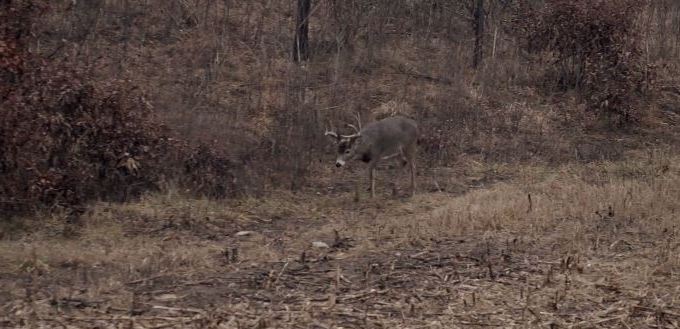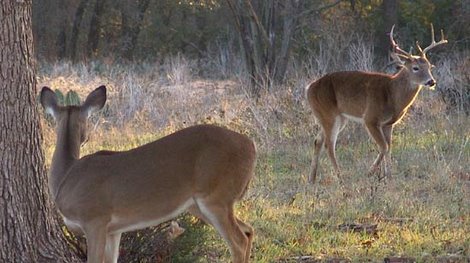The buck to doe ratio over much of the United States is probably somewhere around 1 whitetail buck per 3 to 5 adult whitetail does. This ratio is considered satisfactory for good (annual) production and recruitment of white-tailed deer if one is interested in a quick turnover in the herd.
Essentially, a sex ratio in favor of does can increase the size of a whitetail herd quite quickly each year. As a result, many young bucks and does are often available for harvest each year. A ratio highly skewed towards females is good for maximum deer production, but it’s not necessarily beneficial for optimal quality production. A population skewed towards doe deer is hard on bucks.

Buck to Doe Ratio in Perspective
Thoughts on the ideal buck to doe ratio are quite varied and somewhat controversial in some cases. Depending upon the part of the country you are located, the experiences of the person you are talking with, and a person’s general management philosophies, you will most likely get different answers from every single person you discuss the topic with.
They may all be correct under certain circumstance. The fact is there is no single correct answer for every property out there. However, there are some rules of thumb that may help with the management of the local deer herd.
Deer Sex Ratio: An Example
If a manager wants to harvest a high number of white-tailed deer each year then maintaining many more does than bucks will definitely get you there. For example, let’s say your hunting property is 500 acres. Assuming the proper carrying capacity for this land is roughly 50 deer (1 deer/10 acres) then a buck to doe ratio of 1:4 would mean your deer herd is comprised of 10 bucks and 40 does.
If the annual fawn production, fawn crop is 50 percent then that equates to 20 fawns survive through the summer and into the fall. With this number in mind, the manager must now remove an excess of 20 deer on the property come fall hunting season to keep the overall deer population size in check with the carry capacity and available habitat.
In this example, hunters will have to harvest 10 bucks and 10 does each year to maintain a sex ratio of 1:4 and in order keep the deer population and the proper density. This sounds pretty good since a lot of bucks and does will need to be shot each year (opportunity!), but it will definitely limit the number of mature bucks in the population.

Tightening Up the Ratio
Now, let’s change the scenario. If a manager wants to maintain better quality bucks and have an improved buck age structure, then consider lowering the buck to doe ratio on the property to around to 1:2. This would maintain the herd on our hypothetical 500 acres at 17 bucks and 33 does.
Under these conditions, a fawn crop of 50 percent puts annual fawn production at only 16 animals. With continued herd management in mind, a 1:2 sex ratio can be maintained by harvesting roughly 8 bucks and 8 does each year. It also allows the manager to leave some bucks to grow on the property while also maintaining a proper deer density for the example area, 1 deer for every 10 acres.
1:1 Ratio?
The above examples illustrate how the number of both males and females plays into a whitetail management program. Under a managed situation with a deer herd at carrying capacity the hunter’s annual harvest equals the number of fawns produced by the herd that year.
So, can we take it a bit further? In this example let’s say we want to promote an even better age structure in the buck segment of the herd. Let’s consider shooting for a 1:1 sex ratio, so just 1 buck for every 1 doe.
Okay, back to the hypothetical ranch. The 50 deer on the ranch would now consist of 25 bucks and 25 does. A 50 percent fawn crop means only about 12 fawns. This number looks low compared to the numbers of fawns produced in the prior example, but keep this in mind.
To keep the deer population in check under a 1:1 ratio hunters only need to remove 12 deer, 6 bucks and 6 does. This makes the deer management program a bit easier with respect to total deer harvest because you don’t need to remove as many deer, but the real reward is the number of older age class bucks found within the herd.
Remember, with a ratio of 1:4 ratio we had to shoot all of the adult buck herd annually to maintain the proper number of deer on a ranch. This equates to shooting nothing but 1 1/2 year old (yearling) bucks every year.
A sex ratio closer to 1:1 means hunters need to harvest 6 of the 25 available bucks on the property to maintain the deer herd. So instead of shooting 10 yearling bucks under a 1:4 ratio, hunters are now able to shoot more mature bucks that are likely much better in quality.
Best Buck to Doe Ratio
The deer herd examples above are intended to illustrate how the number of bucks, does and fawns interact on an annual basis. A 50 percent annual fawn crop was chosen because that’s about what it averages in my part of the world. Some years are a better, some worse.
Fawn survival is something that should be considered when thinking about a deer management program. Maintaining the total deer population within the carrying capacity of the habitat will go a long ways towards keeping the whitetail using your property in good condition and will increase fawn survival.
What’s the best buck to doe ratio for your property? The answer depends on the goals of property owner and/or hunters and must take into account many other variables. First, does the size of the property lend itself to some level of deer population management? Other factors that should be considered on a property include:
- Deer density (carrying capacity)
- Average annual fawn production
- Desired total annual deer harvest
- Desired annual buck harvest
- Desired annual buck quality
- Deer harvest on adjacent lands
The buck to doe ratio is a key parameter for the management of a white-tailed deer herd. Decide on a place to start using the above considerations and then manage the herd to get there. That may mean shooting deer or not shooting deer. Once there, evaluate the results of your management actions and adjust according. That’s what management is all about, adapting to the current situation to get to a desired situation.
Do not fall victim to believing that a 1:1 buck to doe ratio is best for your property. Maybe, maybe not. With the proper number of deer on a property and a sex ratio that is closer together the quality of bucks on a property will improve because of adequate food resources, lower energy expenditure during the breeding season, and improved age structure. Maintaining deer numbers will become achievable. The buck to doe ratio does make a difference.